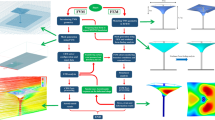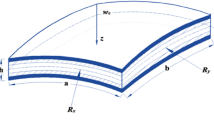Abstract
In a composite material, stiffness and strength in a desired direction can be controlled via the combination and stacking of materials. As such, the application of composite materials has spread to almost every industry. To utilize this advantage in the design of a marine propeller with complex geometry, accurate and practical analysis tools that consider both the hydroelastic behavior and ply-stacking structure of composite materials are required. Therefore, steady and unsteady BEM–FEM FSI algorithms of a composite propeller blade and a simple finite element model that considers the lamination modulus of fiber materials have been introduced in this study. In addition, a comparative study using CFD–FEM-based FSI analysis and numerical investigation of the hydroelastic behavior of a composite propeller in the ship wake field have been performed based on the present methodology.
































Similar content being viewed by others
References
Blasques JP, Berggreen C, Anderson P (2010) Hydro-elastic analysis and optimization of a composite marine propeller. Mar Struct 23:22–38
Chen BY-H, Neely SK, Michael TJ, Gowing S, Szwerc RP, Buchler D, Schult R (2006) Design, fabrication and testing of pitch-adapting (flexible) composite propellers. In: SNAME Propellers/Shafting Symposium
He XD, Hong Y, Wang RG (2012) Hydroelastic optimisation of a composite marine propeller in a non-uniform wake. Ocean Eng 39:14–23
Hess JL, Valarezo WO (1985) Calculation of steady flow about propellers using a surface panel method. J Propuls Power 1:470–476
Hoshino T (1989) Hydrodynamic analysis of propellers in steady flow using a surface panel method. J Soc Naval Archit Jpn 166:79–92
Hsin C-Y (1990) Development and analysis of panel method for propellers in unsteady flow, PhD thesis, Massachusetts Institute of Technology, Dept. of Ocean Engineering
Huang HH, Groves NC (1980) Effective wake: theory and Experiment. In: Proceeding of 13th symp. on naval hydrodynamics, Office of naval research, pp 651–673
Jang H-G, Noh I-S, Hong C-H, Lee C-S (2013) Design algorithm of flexible propeller by fluid-structure interactive analysis. In: Proceeding of the 12th international symposium on practical design of ships and other floating structures
Kerwin JE, Lee C-S (1978) Prediction of steady and unsteady marine propeller performance by numerical lifting surface theory. Trans SNAME 86:218–253
Kröger H, Fröhlingsdorf W (2012) Simulation-based optimization of the manufacturing process for a composite marine propeller. Proceeding of CFK-Valley stade convention
Lee H, Song M-C, Suh J-C, Chang B-J (2014) Hydro-elastic analysis of marine propellers based on a BEM–FEM coupled FSI algorithm. Int J Naval Archit Ocean Eng 6:562–577
Lee H, Song M-C, Suh J-C, Cha M-C, Chang B-J (2015) A numerical study on the hydro-elastic behavior of composite marine propeller. In: 4th International symposium on marine propulsors (smp’15), pp 170–176
Lee J-T (1987) A potential based panel method for the analysis of marine propellers in steady flow. Ph.D. thesis, Massachusetts Institute of Technology, Dept. of Ocean Engineering
Luhar M, Nepf HM (2011) Flow-induced reconfiguration of buoyant and flexible aquatic vegetation. Limnol Oceanogr 56:2003–2017
Lin H, Lin J (1996) Nonlinear hydroelastic behavior of propellers using a finite element method and lifting surface theory. J Mar Sci Technol 1:114–124
Motley MR, Liu Z, Young YL (2009) Utilizing fluid-structure interactions to improve energy efficiency of composite marine propellers in spatially varying wake. Compos Struct 90:304–313
Paik KJ (2010) Simulation of fluid-structure interaction for surface ships with linear/nonlinear deformationszn. Ph.D. thesis, University of Iowa
Tian F-B, Dai H, Luo H, Doyle JF, Rousseau B (2014) Fluid-structure interaction involving large deformations: 3D simulations and applications to biological systems. J Comput Phys 258:451–469
Young YL (2007) Time-dependent hydroelastic analysis of cavitating propulsors. J Fluids Struct 23:269–295
Young YL, Liu Z (2007) Hydroelastic tailoring of composite naval propulsors. In: Proceedings of the 26th international conference on offshore mechanics and arctic engineering, OMAE2007-29648
Young YL (2008) Fluid-structure interaction analysis of flexible composite marine propellers. J Fluids Struct 24:799–818
Author information
Authors and Affiliations
Corresponding author
About this article
Cite this article
Lee, H., Song, MC., Han, S. et al. Hydro-elastic aspects of a composite marine propeller in accordance with ply lamination methods. J Mar Sci Technol 22, 479–493 (2017). https://doi.org/10.1007/s00773-016-0428-4
Received:
Accepted:
Published:
Issue Date:
DOI: https://doi.org/10.1007/s00773-016-0428-4




